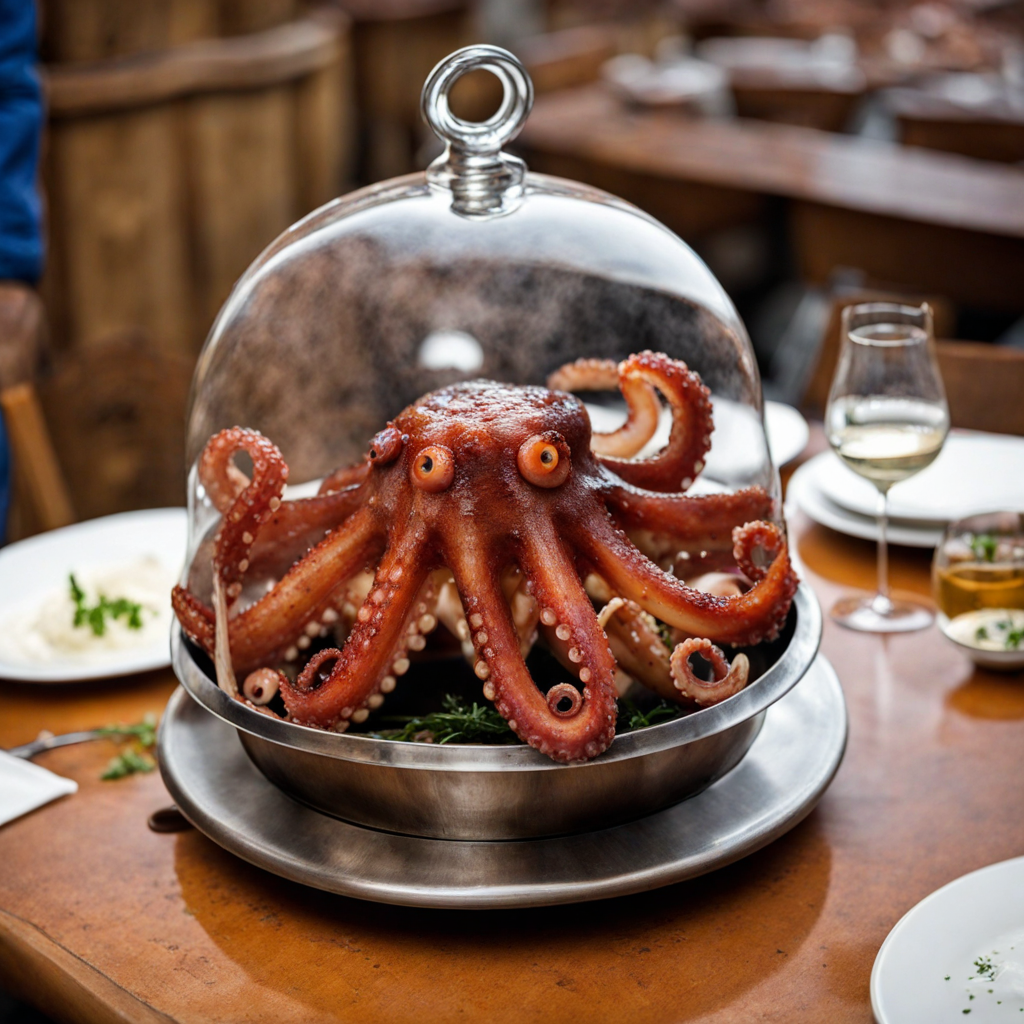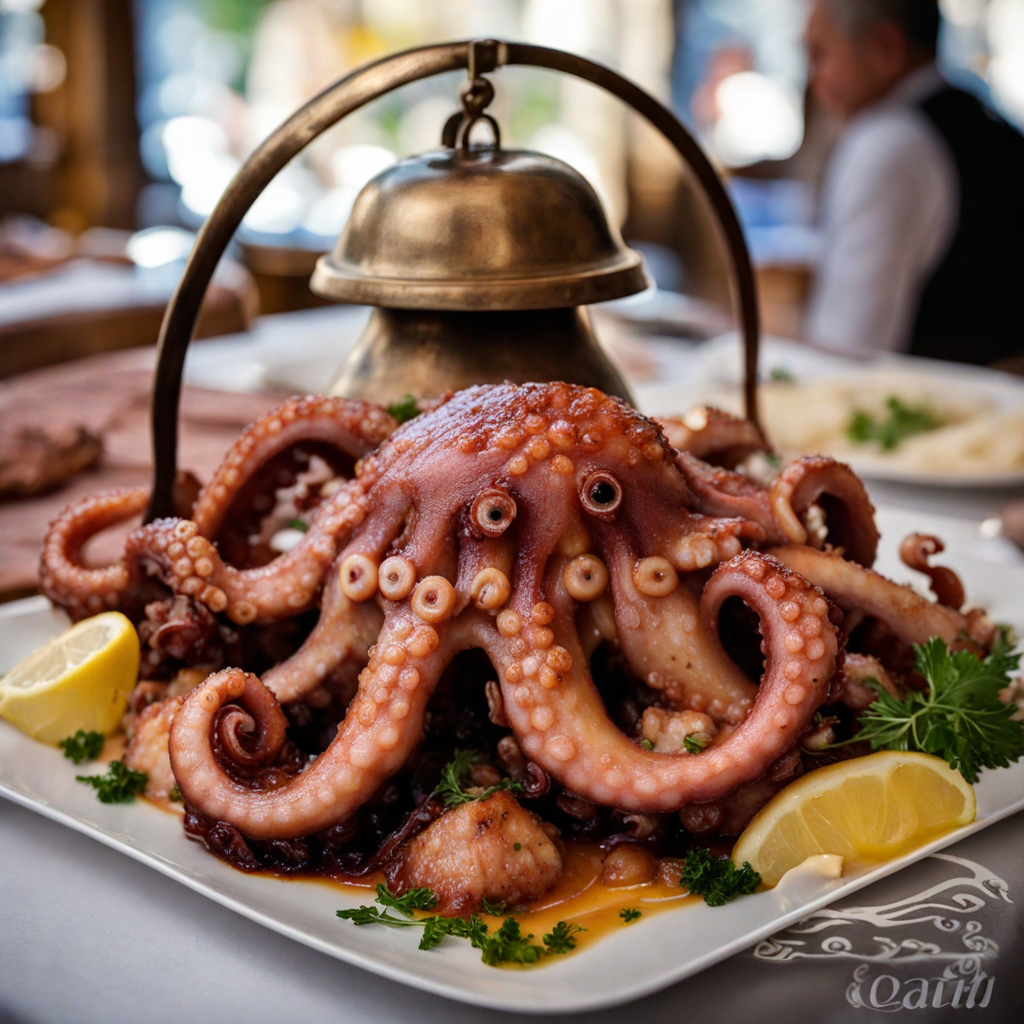Octopus Under the Bell
Octopus Under the Bell, or "Hobotnica ispod Peke," is a traditional Croatian dish that showcases the country's rich coastal culinary heritage. This exquisite meal is prepared using a unique cooking method that involves placing the octopus and accompanying ingredients under a heavy bell-like lid, known as a "peka." The dish is typically cooked over a wood fire, allowing the flavors to meld beautifully while the octopus becomes tender and succulent. The combination of local herbs, potatoes, and sometimes seasonal vegetables enhances the oceanic flavor of the octopus, creating a harmonious balance that is both hearty and refreshing. The preparation begins with the freshest octopus, often sourced from the Adriatic Sea, known for its vibrant taste and texture. The octopus is marinated with olive oil, garlic, and aromatic herbs like rosemary and parsley, infusing it with a depth of flavor. As it cooks under the peka, the steam created from the ingredients not only tenderizes the octopus but also imparts a subtle smokiness from the wood fire. The result is a dish that is visually appealing, with vibrant colors and rich aromas that evoke the essence of the Croatian coastline. When served, Octopus Under the Bell is often accompanied by a drizzle of high-quality Croatian olive oil and a sprinkle of sea salt, enhancing its natural flavors. Diners are greeted with a dish that is both rustic and elegant, perfect for sharing among friends and family. Each bite offers a taste of the Adriatic, with the octopus being tender yet firm, paired with the earthiness of the potatoes and the fragrant herbs. This dish not only satisfies the palate but also tells a story of Croatian culture and tradition, making it a must-try for anyone looking to explore new culinary horizons.
How It Became This Dish
The Rich Tapestry of Hobotnica Ispod Peke: A Culinary Journey Through Time in Croatia #### Origins and Ingredients Hobotnica ispod peke, a traditional Croatian dish, translates to "octopus under the bell" in English. This tantalizing preparation method involves slow-cooking octopus (hobotnica) along with vegetables such as potatoes, onions, and sometimes tomatoes, all enveloped in a cast-iron pot covered with a metal bell-like lid known as a "peka." The dish embodies the essence of Mediterranean cuisine, merging fresh seafood with the heartiness of local agriculture. The origins of hobotnica ispod peke can be traced back to the coastal regions of Croatia, particularly Dalmatia, where fishing has long been a vital part of the local economy and culture. The method of cooking under the peka is believed to have ancient roots, likely influenced by the cooking techniques of the Greeks and Romans, who utilized similar methods of baking and roasting to prepare their meals. The peka itself is a traditional Croatian cooking implement that typically consists of a shallow metal dish covered by a dome, allowing for slow, moist cooking with the use of hot coals. This cooking method not only preserves the flavors of the ingredients but also enhances them, creating a dish that is both tender and deeply flavorful. #### Cultural Significance Hobotnica ispod peke is more than just a dish; it is a culinary symbol of Croatian culture and heritage. The act of preparing and sharing this meal often takes place during family gatherings and celebrations, highlighting the importance of community and tradition in Croatian society. The dish is often associated with coastal towns and islands, where locals take pride in their fishing traditions and the bounty of the Adriatic Sea. In Croatia, food is a significant aspect of social life, and hobotnica ispod peke exemplifies this connection. The preparation of the dish is usually a communal activity, where family members gather to prepare the ingredients, light the fire, and share stories while waiting for the meal to cook. This shared experience fosters bonds among family and friends, making the dish a centerpiece of Croatian hospitality. Furthermore, the dish reflects the principles of the Mediterranean diet, which emphasizes fresh, local ingredients and traditional cooking methods. The octopus used in this dish is typically caught by local fishermen, ensuring that the meal is both sustainable and reflective of the region's natural resources. The use of seasonal vegetables not only enhances the dish's flavor but also promotes the values of eating locally and seasonally. #### Development Over Time Over the years, hobotnica ispod peke has evolved while remaining true to its roots. Initially, this dish was a staple for fishermen and their families, who would prepare meals with the catch of the day. As tourism began to flourish in Croatia, particularly in the late 20th century, this traditional dish started to gain recognition beyond local circles, becoming a beloved offering in restaurants across the country. Modern interpretations of hobotnica ispod peke have emerged, with chefs experimenting with different ingredients and techniques while still honoring the traditional method of cooking under the peka. While the classic version remains popular, some culinary innovators have introduced variations such as adding spices or incorporating other seafood, further enhancing the dish's appeal to a broader audience. This evolution reflects a growing trend in Croatian cuisine, where traditional dishes are embraced and reimagined to cater to contemporary tastes without losing their cultural significance. In recent years, the rise of gastronomy tourism has contributed to the dish's prominence on the international stage. Tourists flock to the Croatian coast not only for its stunning landscapes but also to indulge in its rich culinary heritage. Restaurants and local eateries often feature hobotnica ispod peke on their menus, showcasing the dish as a must-try experience for visitors. This newfound attention has led to a resurgence of interest in traditional Croatian cooking methods, inspiring both locals and tourists to appreciate the importance of preserving culinary heritage. #### The Cultural Revival and Future of Hobotnica Ispod Peke As a part of Croatia's cultural revival in the 21st century, there has been a concerted effort to preserve traditional cooking techniques and recipes like hobotnica ispod peke. Culinary schools and local communities have begun to prioritize the teaching of these methods to younger generations, ensuring that the knowledge and appreciation of such dishes are passed down. Moreover, the rise of social media and food blogging has provided a platform for chefs and home cooks to share their interpretations of hobotnica ispod peke, sparking interest and enthusiasm for Croatian cuisine worldwide. Videos showcasing the preparation of the dish often go viral, illustrating the communal nature of cooking and the joy of sharing food with loved ones. In the context of globalization, the future of hobotnica ispod peke appears bright. While the dish remains firmly rooted in its traditional origins, the willingness to adapt and innovate ensures that it continues to resonate with contemporary diners. The integration of local ingredients and innovative techniques will likely pave the way for new culinary explorations, allowing this cherished dish to thrive in an ever-changing gastronomic landscape. #### Conclusion Hobotnica ispod peke is a dish steeped in history, culture, and tradition, embodying the spirit of Croatian coastal life. Its origins reflect the resourcefulness of fishermen and their families, while its communal preparation showcases the importance of togetherness in Croatian culture. As it continues to evolve and adapt to modern tastes, hobotnica ispod peke remains a testament to the power of food as a bridge between generations, uniting people through shared experiences and cherished memories. Whether enjoyed in a quaint coastal restaurant or prepared at home among family, it serves as a delicious reminder of Croatia's rich culinary heritage and the enduring significance of tradition in an ever-changing world.
You may like
Discover local flavors from Croatia







